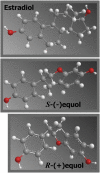Equol: pharmacokinetics and biological actions
- PMID: 20519411
- PMCID: PMC2884334
- DOI: 10.3945/jn.109.119784
Equol: pharmacokinetics and biological actions
Abstract
Equol [7-hydroxy-3-(4'-hydroxyphenyl)-chroman], an isoflavan produced by intestinal bacteria in response to soy isoflavone intake in some but not all humans, exhibits a wide range of biological properties. It exists as the diastereoisomers S-(-)equol and R-(+)equol. Intestinal bacteria produce exclusively S-(-)equol, which has selective affinity for estrogen receptor (ER)-beta. The evidence is conflicting on whether there is an advantage to producing S-(-)equol in response to soy isoflavone intakes, but the ability to now synthesize these diastereoisomers opens the way for future clinical trials to directly examine their potential in a number of hormone-dependent conditions. In this review, the plasma and urinary pharmacokinetics of S-(-)equol and R-(+)equol are reviewed and summarized, and some of the more recent evidence supporting potential biological effects of S-(-)equol is considered.
Figures
Similar articles
-
Equol: history, chemistry, and formation.J Nutr. 2010 Jul;140(7):1355S-62S. doi: 10.3945/jn.109.119776. Epub 2010 Jun 2. J Nutr. 2010. PMID: 20519412 Free PMC article. Review.
-
S-equol, a potent ligand for estrogen receptor beta, is the exclusive enantiomeric form of the soy isoflavone metabolite produced by human intestinal bacterial flora.Am J Clin Nutr. 2005 May;81(5):1072-9. doi: 10.1093/ajcn/81.5.1072. Am J Clin Nutr. 2005. PMID: 15883431 Clinical Trial.
-
The pharmacokinetic behavior of the soy isoflavone metabolite S-(-)equol and its diastereoisomer R-(+)equol in healthy adults determined by using stable-isotope-labeled tracers.Am J Clin Nutr. 2009 Oct;90(4):1029-37. doi: 10.3945/ajcn.2009.27981. Epub 2009 Aug 26. Am J Clin Nutr. 2009. PMID: 19710188 Free PMC article. Clinical Trial.
-
The clinical importance of the metabolite equol-a clue to the effectiveness of soy and its isoflavones.J Nutr. 2002 Dec;132(12):3577-84. doi: 10.1093/jn/132.12.3577. J Nutr. 2002. PMID: 12468591 Review.
-
S-(-)equol producing status not associated with breast cancer risk among low isoflavone-consuming US postmenopausal women undergoing a physician-recommended breast biopsy.Nutr Res. 2014 Feb;34(2):116-25. doi: 10.1016/j.nutres.2013.12.002. Epub 2013 Dec 18. Nutr Res. 2014. PMID: 24461312 Free PMC article.
Cited by
-
The soy isoflavone equol may increase cancer malignancy via up-regulation of eukaryotic protein synthesis initiation factor eIF4G.J Biol Chem. 2012 Dec 7;287(50):41640-50. doi: 10.1074/jbc.M112.393470. Epub 2012 Oct 24. J Biol Chem. 2012. PMID: 23095751 Free PMC article.
-
The impact of equol-producing status in modifying the effect of soya isoflavones on risk factors for CHD: a systematic review of randomised controlled trials.J Nutr Sci. 2016 Jul 19;5:e30. doi: 10.1017/jns.2016.18. eCollection 2016. J Nutr Sci. 2016. PMID: 27547393 Free PMC article. Review.
-
Enterocyte-Associated Microbiome of the Hadza Hunter-Gatherers.Front Microbiol. 2016 Jun 6;7:865. doi: 10.3389/fmicb.2016.00865. eCollection 2016. Front Microbiol. 2016. PMID: 27375586 Free PMC article.
-
The role of colonic bacteria in the metabolism of the natural isoflavone daidzin to equol.Metabolites. 2015 Jan 14;5(1):56-73. doi: 10.3390/metabo5010056. Metabolites. 2015. PMID: 25594250 Free PMC article. Review.
-
Elucidation of Prebiotics, Probiotics, Postbiotics, and Target from Gut Microbiota to Alleviate Obesity via Network Pharmacology Study.Cells. 2022 Sep 16;11(18):2903. doi: 10.3390/cells11182903. Cells. 2022. PMID: 36139478 Free PMC article.
References
-
- Jensen EV. On the mechanism of estrogen action. Perspect Biol Med. 1962;6:47–59. - PubMed
-
- Morito K, Hirose T, Kinjo J, Hirakawa T, Okawa M, Nohara T, Ogawa S, Inoue S, Muramatsu M, et al. Interaction of phytoestrogens with estrogen receptors α and β. Biol Pharm Bull. 2001;24:351–6. - PubMed
-
- Muthyala RS, Ju YH, Sheng S, Williams LD, Doerge DR, Katzenellenbogen BS, Helferich WG, Katzenellenbogen JA. Equol, a natural estrogenic metabolite from soy isoflavones: convenient preparation and resolution of R- and S-equols and their differing binding and biological activity through estrogen receptors alpha and beta. Bioorg Med Chem. 2004;12:1559–67. - PubMed
Publication types
MeSH terms
Substances
Grants and funding
LinkOut - more resources
Full Text Sources
Other Literature Sources


